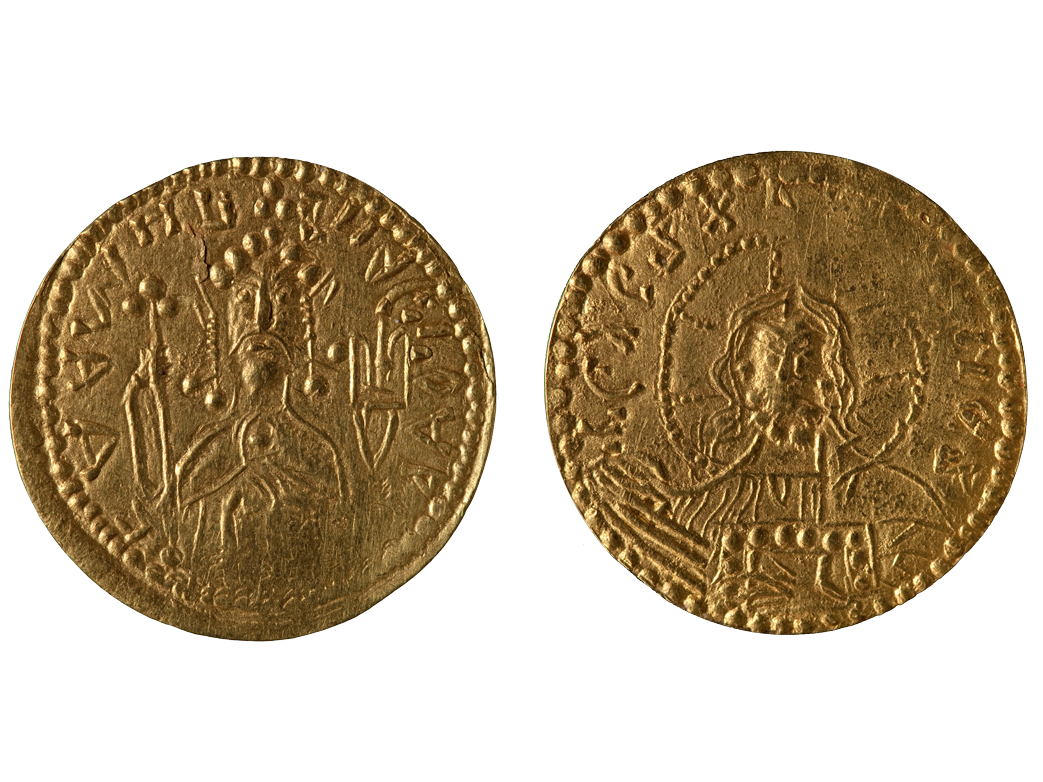Zlatnik of prince Vladimir Sviatoslavich

On a front side is an image of a sitting on a throne prince; there is a hat on the prince’s head with pendants by sides and a cross on its top. With his right hand he is carrying a cross on a long wooden hold, his left hand is on his chest. Over the left shoulder a prince’s symbol is (a trident or a “symbol of the Riurikids”). The circular inscription from right to left with tops of letters to the center is: Vladimir on the throne. On the reverse side is placed a chest-high portrait of Christ in cross-shaped pattern wreath, with a gospel in the left hand and blessing with his right hand. The circular inscription is: Jesus Christ. On the front side and the reverse side a double beads rim is placed.
The first Russian coin, a mintage of which started in Kievan Rus after the adoption of Christianity in 988 as a state’s religion. Simultaneously started the mintage of silver coins. First Russian coins took example by Byzantium coins in their weight and design. On a coin is placed the most ancient Russian portrait quite accurately reflecting traits of saint and equal-to-the-apostles prince Vladimir who was described by his contemporaries: “with bushy eyebrows… a flat nose, a shaved beard and bushy long hair over the upper lip”.
Not coincidentally of all others zlatniks became first Russian coins: according to the ancient concerns only gold was the image of fame, powers and a divine origin of a ruler. Vladimir is depicted on a coin with regalia alike regalia of Byzantium emperors; the image of the Riurikids’ symbol is equal to the claim of Kievan Rus’ independence. An ideologic content of images and inscriptions on first Russian coins witnesses the depth and earnest of ideological battle of the Ancient Rus’s state for political and church independence from Byzantium in the first years after the adoption of Christianity.
Prince Vladimir Sviatoslavovich (980–1015) – the grandson of princess Olga (945–957), the third son of Prince Sviatoslav (957–972).
After Sviatoslavs’ death the grand prince of Kiev became his eldest son Yaropolk (972–980). His brother Oleg got Drevlians’ land. The third son of Sviatoslav, born from his slave Malusha, a key-keeper of princess Olga, got Novgorod. Five years after between brothers a feud started. Yaroslav defeated Drevlians’ druzhinas of Oleg. Oleg himself died in a battle.
Vladimir run away “beyond the sea”, from where after two years he came back with employed Varangians’ druzhina. Yaropolk was killed. Vladimir took the grand prince’s throne.
While prince Vladimir’s rule all lands of eastern Slavic united inside the Kievan Rus’. One of the most important problems of that time was solved: a protection of Russian lands from incursions of Petcheneg tribes (turkic speaking nomad tribes).
In 988 as a states’ religion Christianity was adopted.
Christianization of Vladimir and his druzhina took place in Korsun (Chersonese) – a center of Byzantium lands in the Crimea (Chersonese is located in the boundaries of modern Sevastopol).
After his christening, Vladimir christened his boyars and later all the folk.
The adoption of the Christianity became a beginning point for spreading of a book-learning and a writing, that was a huge importance for development of Russian culture, that experienced the influence of the Byzantium culture and through it of antique culture.
The adoption of the Christianity in an orthodox tradition became one of the defining factors of further historical development of the ancient Russian state. Vladimir was canonized by the Church as a saint and for his merits in Christianization of Rus’ he is called Equal-to-the-Apostles.
